Non-Invasive Glucose Monitoring Device Market Size
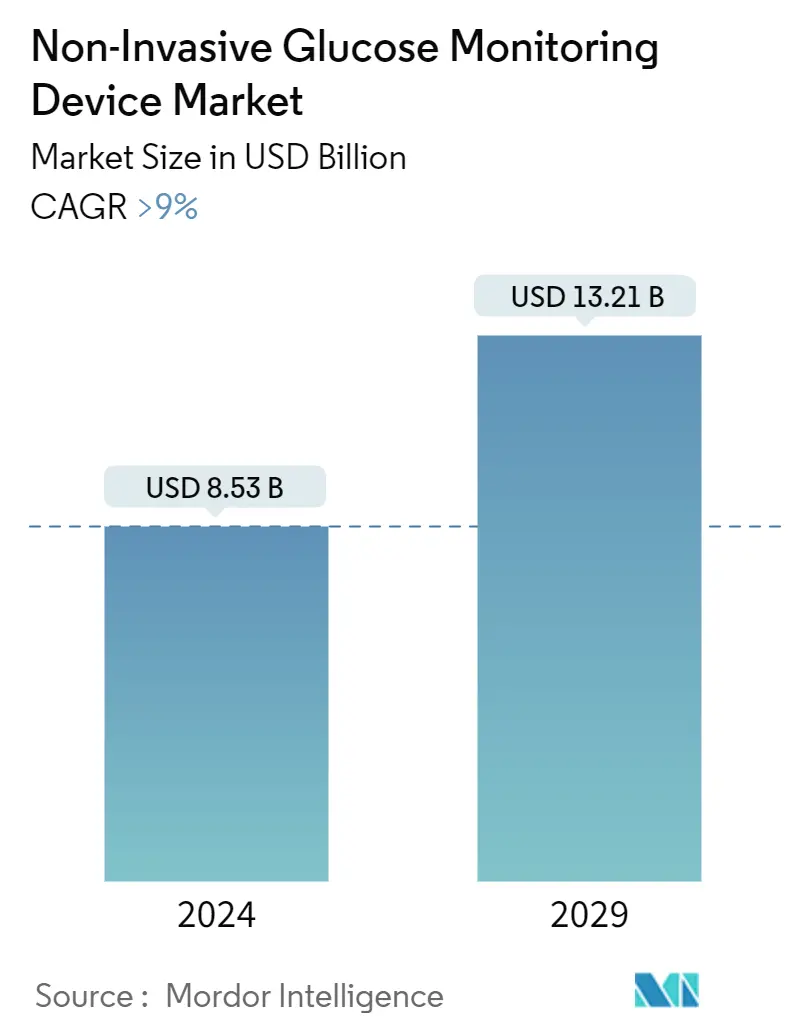
| Study Period | 2018-2029 |
| Market Size (2024) | USD 8.53 Billion |
| Market Size (2029) | USD 13.21 Billion |
| CAGR (2024 - 2029) | 9.00 % |
| Fastest Growing Market | Asia Pacific |
| Largest Market | North America |
Major Players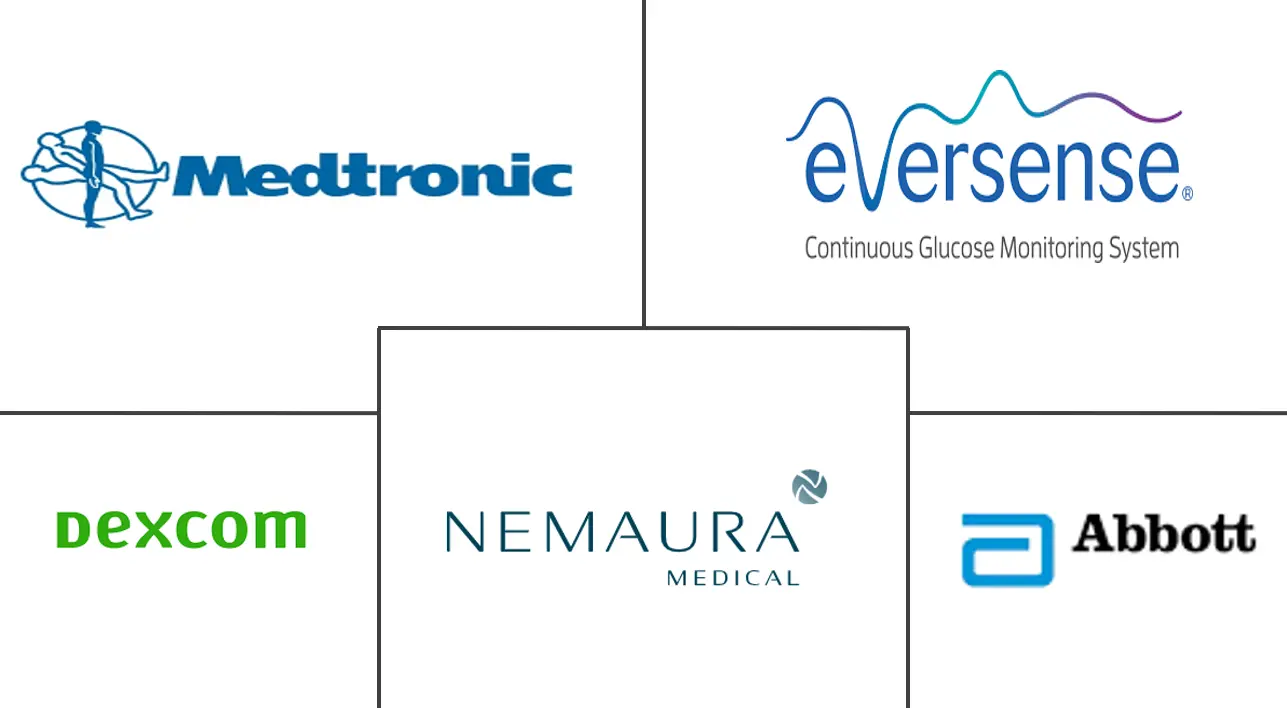
*Disclaimer: Major Players sorted in no particular order |
Non-Invasive Glucose Monitoring Device Market Analysis
The Non-Invasive Glucose Monitoring Device Market size is estimated at USD 8.53 billion in 2024, and is expected to reach USD 13.21 billion by 2029, growing at a CAGR of greater than 9% during the forecast period (2024-2029).
Non-invasive glucose meters represent devices that assess blood glucose levels without the need for blood extraction. This confers a notable benefit when compared to conventional glucose meters, as they necessitate a fingerstick to procure a blood sample. Non-invasive glucose meters are presently undergoing development, with numerous promising technologies currently under investigation.
Diabetes was recognized as a risk factor for numerous severe infections, particularly for the rapid progression and unfavorable prognosis of COVID-19. Consequently, individuals with diabetes needed heightened attention. This presented a significant clinical hurdle in managing diabetes during the pandemic period.
To mitigate the risk of coronavirus transmission, remote monitoring of glucose levels is imperative to deliver tailored home care. As a result, the advancement of personalized, continuous glucose monitoring (CGM) has garnered increased interest in effectively managing diabetes and preventing the spread of the virus. Therefore, in these unparalleled times, telemedicine intervention supporting CGM emerges as an ideal solution for diabetes management. It enables remote clinical consultations for diabetes patients through glucose self-monitoring, aided by personalized CGM devices. This approach not only maintains the effectiveness of diabetes care but also minimizes exposure to the virus among patients and residents, thereby contributing to global efforts against COVID-19.
Non-invasive glucose meters offer several benefits over traditional glucose meters, including the elimination of pain or discomfort. With no need for fingersticks, users can enjoy a painless and comfortable experience. Additionally, non-invasive glucose meters can be used more frequently since they don't require a blood sample, providing enhanced convenience. By offering more frequent glucose readings, non-invasive glucose meters can help individuals with diabetes achieve better glycemic control.
Certain obstacles must be overcome before non-invasive glucose meters can be embraced on a large scale despite their potential advantages. These obstacles include the fact that non-invasive glucose meters are not as precise as conventional glucose meters and can be influenced by factors such as skin temperature and humidity. Additionally, non-invasive glucose meters are usually more costly than traditional glucose meters.
Despite the obstacles, there exists considerable optimism regarding the prospects of non-invasive glucose meters in the future. Scientists persist in their efforts to innovate and create more precise and dependable technologies. With the progression of these technologies, it is anticipated that non-invasive glucose meters will likely become increasingly accessible and cost-effective.
Non-Invasive Glucose Monitoring Device Market Trends
The market for non-invasive continuous glucose monitoring (nCGM) devices is projected to witness substantial growth in the upcoming years
The market for non-invasive continuous glucose monitoring (nCGM) devices is projected to witness substantial growth in the upcoming years due to various factors. These factors include: By 2030, it is projected by the World Health Organization (WHO) that the global population of adults with diabetes will surge to 578 million, highlighting the alarming rise in diabetes prevalence. Additionally, there is a growing demand for glucose monitoring methods that are convenient and painless, which non-invasive CGM devices fulfill. Moreover, the progress in technology is playing a significant role in the enhancement of accurate and reliable non-invasive CGM devices.
Abbott Laboratories, Dexcom, and Senseonics are among the prominent corporations engaged in the development and commercialization of nCGM devices. These companies are making substantial investments in research and development to enhance the precision and dependability of their nCGM devices, as well as to broaden their market presence.
nCGM devices possess the capability to greatly enhance the management of diabetes through the provision of real-time glucose monitoring. This feature aids in the prevention of both hypoglycemia and hyperglycemia. Additionally, nCGM devices offer healthcare providers valuable data that can assist them in making more informed treatment decisions.
The outlook for nCGM devices appears promising. Scientists are persistently working on advancing novel technologies that offer improved accuracy, dependability, and affordability. Moreover, the integration of nCGM devices with other diabetes management tools like insulin pumps and smartphone apps is on the rise. This integration is set to enhance the convenience and effectiveness of nCGM devices for individuals living with diabetes.
Here are some of the significant trends that are anticipated to shape the future of nCGM devices:
1. Enhanced precision: Scientists are actively working on new technologies to enhance the accuracy of nCGM devices.
2. Improved comfort: nCGM devices are being designed to be smaller, lighter, and more comfortable for users.
3. Integration with diabetes management tools: nCGM devices are being seamlessly integrated with other diabetes management tools like insulin pumps and smartphone apps.
4. Real-time insulin dosing: Researchers are making advancements in nCGM devices to enable real-time insulin dosing, potentially revolutionizing the management of type 1 diabetes.
As these trends continue to progress, nCGM devices are expected to play an increasingly vital role in diabetes management.
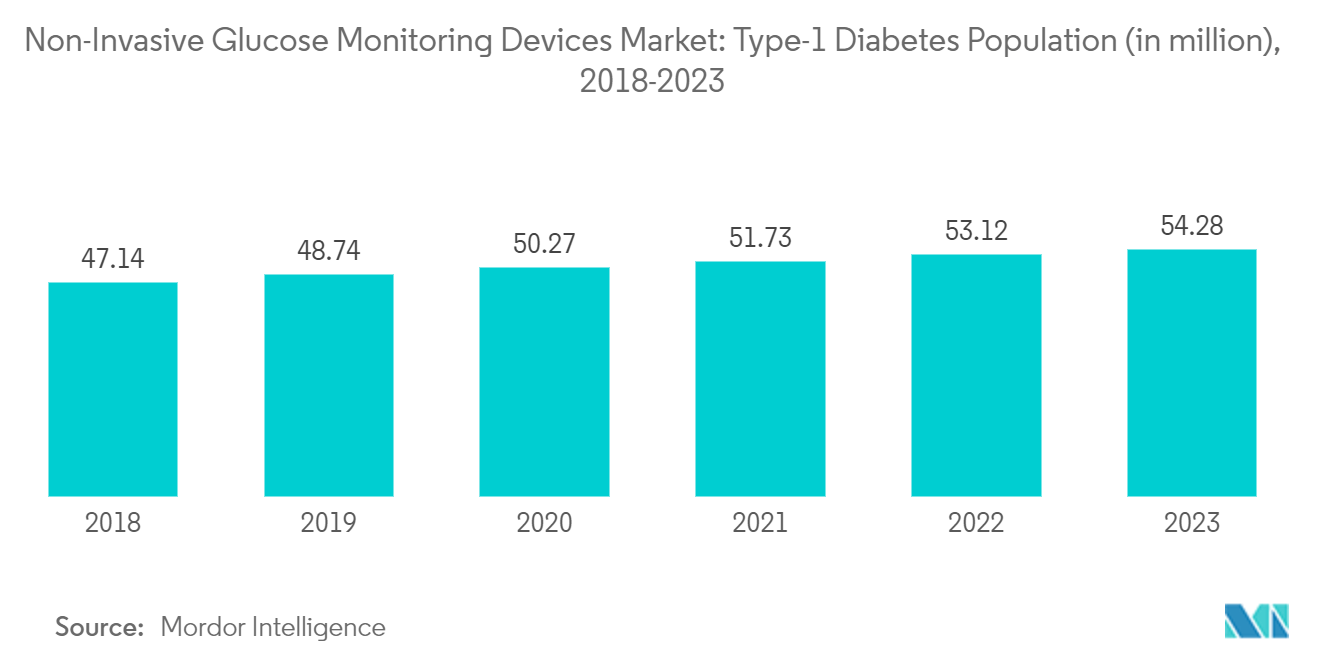
The North American region is Expected to Witness the Highest Growth Rate Over the Forecast Period
Two main factors are propelling the market for non-invasive glucose devices. Firstly, the rising prevalence of diabetes, particularly in North America, is a significant driver. According to the International Diabetes Federation, there are currently over 46 million adults with diabetes in this region, and this number is projected to exceed 55 million by 2030.
Secondly, there is a growing demand for non-invasive methods of glucose monitoring. Traditional invasive techniques, such as finger pricks, can be painful and inconvenient for patients. Non-invasive devices offer a more comfortable and convenient alternative, which is why their popularity is increasing.
Additionally, the increasing adoption of wearable technology is also contributing to the market's growth. Wearable devices like smartwatches and fitness trackers can be seamlessly integrated with non-invasive glucose monitoring devices, enabling continuous glucose monitoring.
Lastly, the market is being driven by the growing awareness of the benefits of non-invasive glucose monitoring. These devices have the potential to enhance diabetes management and prevent complications, which is why more individuals are recognizing their value.
The North American market for non-invasive glucose devices is projected to witness sustained growth in the forthcoming years. This can be attributed to the rising prevalence of diabetes, the surging demand for non-invasive glucose monitoring techniques, and the growing acceptance of wearable technology. Furthermore, the market is anticipated to gain advantages from the advancements in novel non-invasive glucose monitoring technologies.
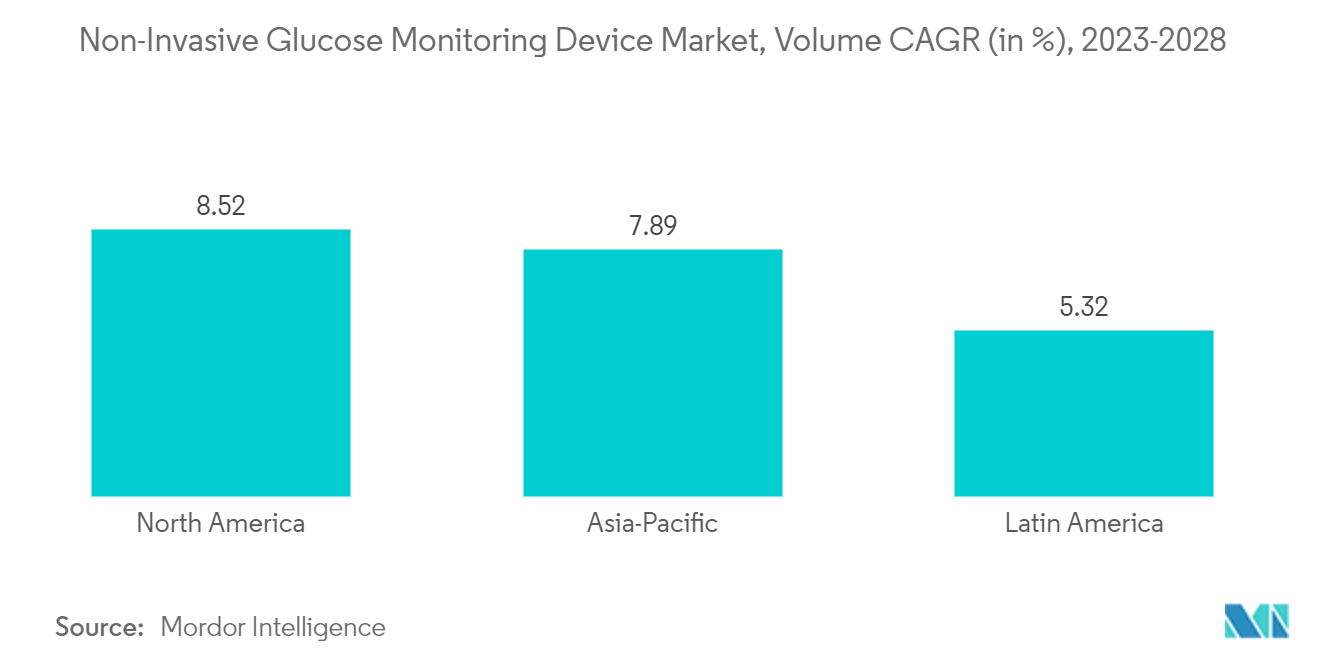
Non-Invasive Glucose Monitoring Device Industry Overview
The non-invasive glucose monitoring devices market is consolidated with few significant players. The major players are working on innovations in the non-invasive market which is evident from the companies spending on research and developments to strengthen their market presence.
Non-Invasive Glucose Monitoring Device Market Leaders
-
Abbott
-
Dexcom
-
Medtronics
-
Eversence
-
Nemaura
*Disclaimer: Major Players sorted in no particular order
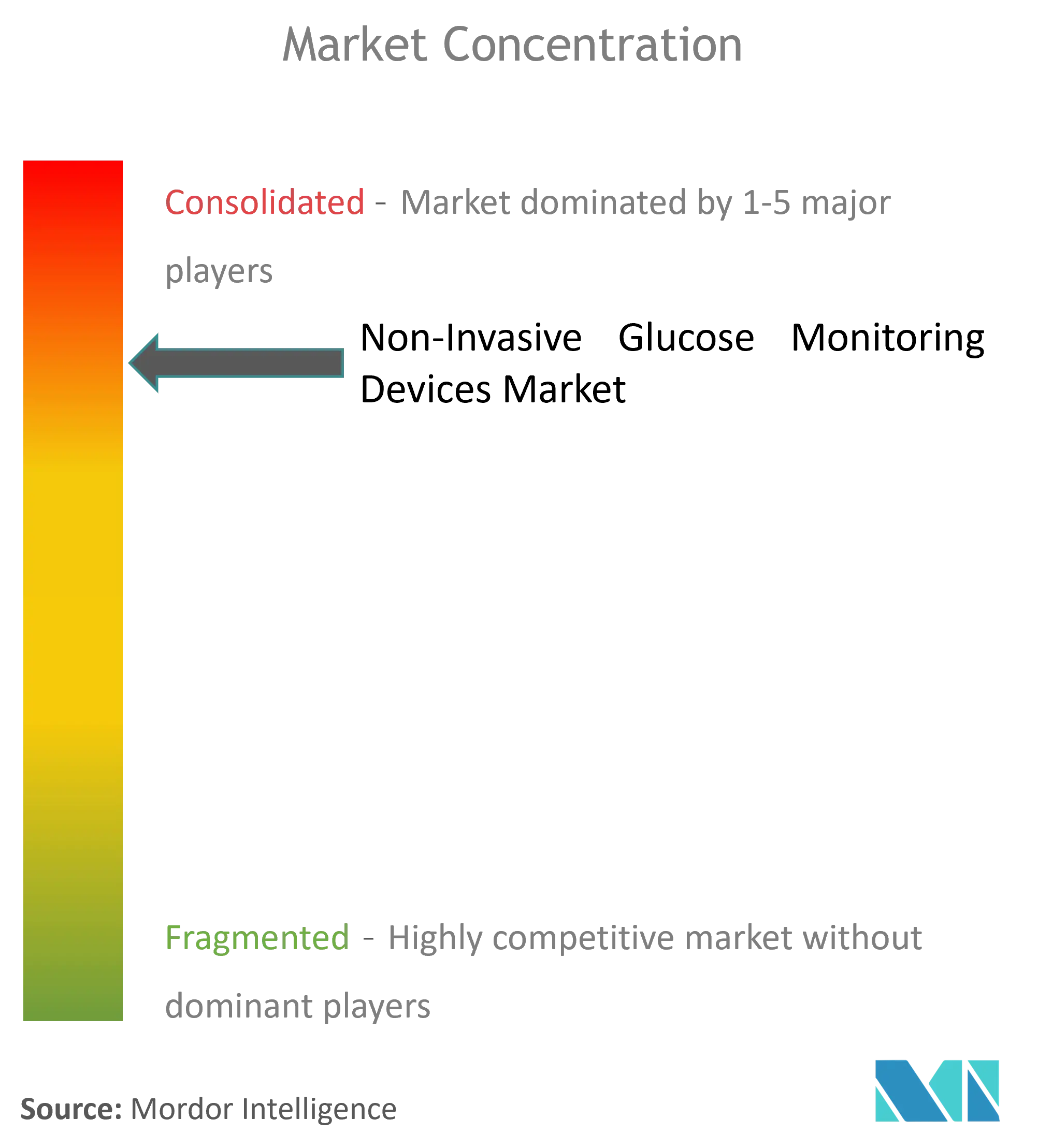
Non-Invasive Glucose Monitoring Device Market News
- September 2023: Nemaura Medical recently concluded a clinical trial involving 100 patients who used the sugarBEAT, a non-invasive and flexible continuous glucose monitor. The study was conducted in the Middle East and consisted of four groups, each with an equal number of male and female participants aged between 18 and 75 years. Among the participants, 20 had type 1 diabetes, while the rest had type 2 diabetes.
- August 2023: Nemaura Medical obtained authorization from the Saudi Food and Drug Authority (SFDA) for its non-invasive wearable glucose sensor, sugarBEAT. After a collaborative effort of over a year with the SFDA, facilitated by the company's licensee in the Middle East, The Principles MENA DMCC (TPMENA), Nemaura was granted this approval. Prior to this, Nemaura had received a provisional purchase order for 1.7 million sensors and 17,000 devices from TPMENA.
Non-Invasive Glucose Monitoring Device Market Report - Table of Contents
1. INTRODUCTION
- 1.1 Study Assumptions and Market Definition
- 1.2 Scope of the Study
2. RESEARCH METHODOLOGY
3. EXECUTIVE SUMMARY
4. MARKET DYNAMICS
- 4.1 Market Overview
- 4.2 Market Drivers
- 4.3 Market Restraints
-
4.4 Porter's Five Forces Analysis
- 4.4.1 Bargaining Power of Suppliers
- 4.4.2 Bargaining Power of Consumers
- 4.4.3 Threat of New Entrants
- 4.4.4 Threat of Substitute Products and Services
- 4.4.5 Intensity of Competitive Rivalry
-
4.5 By Application
- 4.5.1 Arm/ Wrist
- 4.5.2 Ear Lobe
- 4.5.3 Forefinger
- 4.5.4 Thumb
- 4.5.5 Cornea/ Eye
-
4.6 By Technology
- 4.6.1 Near Infrared Spectroscopy (NIRS)
- 4.6.2 Raman Spectroscopy
- 4.6.3 Photo-acoustic Spectroscopy (PA)
- 4.6.4 Optical Coherence Tomography (OCT)
- 4.6.5 Mid-Infrared Spectroscopy (Mid-IRS)
- 4.6.6 Other Technologies
5. MARKET SEGMENTATION
-
5.1 Type
- 5.1.1 Wearable
- 5.1.2 Non Wearable
-
5.2 By End User
- 5.2.1 Hospitals/Clinics
- 5.2.2 Home/Personal
- 5.2.3 Optical Strips
-
5.3 Geography
- 5.3.1 North America
- 5.3.1.1 United States
- 5.3.1.2 Canada
- 5.3.1.3 Rest of North America
- 5.3.2 Europe
- 5.3.2.1 France
- 5.3.2.2 Germany
- 5.3.2.3 Italy
- 5.3.2.4 Spain
- 5.3.2.5 United Kingdom
- 5.3.2.6 Russia
- 5.3.2.7 Rest of Europe
- 5.3.3 Latin America
- 5.3.3.1 Mexico
- 5.3.3.2 Brazil
- 5.3.3.3 Rest of Latin America
- 5.3.4 Asia-Pacific
- 5.3.4.1 Japan
- 5.3.4.2 South Korea
- 5.3.4.3 China
- 5.3.4.4 India
- 5.3.4.5 Australia
- 5.3.4.6 Vietnam
- 5.3.4.7 Malaysia
- 5.3.4.8 Indonesia
- 5.3.4.9 Thailand
- 5.3.4.10 Rest of Asia-Pacific
- 5.3.5 Middle East and Africa
- 5.3.5.1 Saudi Arabia
- 5.3.5.2 Iran
- 5.3.5.3 Egypt
- 5.3.5.4 Oman
- 5.3.5.5 South Africa
- 5.3.5.6 Rest of Middle East and Africa
6. MARKET INDICATORS
- 6.1 Type-1 Diabetes Population
- 6.2 Type-2 Diabetes Population
7. COMPETITIVE LANDSCAPE
-
7.1 Company Profiles
- 7.1.1 Abbott
- 7.1.2 Dexcom
- 7.1.3 Medtronics
- 7.1.4 Eversence
- 7.1.5 MediWise
- 7.1.6 Nemaura
- 7.1.7 OrSense
- 7.1.8 Scanbo
- 7.1.9 DiaMonTech
- *List Not Exhaustive
8. MARKET OPPORTUNITIES AND FUTURE TRENDS
** Subject To AvailablityNon-Invasive Glucose Monitoring Device Industry Segmentation
Non-invasive blood glucose monitoring, as its name suggests, pertains to the identification of human blood glucose levels without inflicting harm on human tissues.
The non-invasive glucose monitoring device market is segmented by type (wearable and handled), by end-user (hospitals, clinics, and home care/personal), and by geography (North America, Europe, Asia-Pacific, the Middle East, Africa, and Latin America).
The report offers the value (in USD) and volume (in Units) for the above segments.
| Type | Wearable | |
| Non Wearable | ||
| By End User | Hospitals/Clinics | |
| Home/Personal | ||
| Optical Strips | ||
| Geography | North America | United States |
| Canada | ||
| Rest of North America | ||
| Geography | Europe | France |
| Germany | ||
| Italy | ||
| Spain | ||
| United Kingdom | ||
| Russia | ||
| Rest of Europe | ||
| Geography | Latin America | Mexico |
| Brazil | ||
| Rest of Latin America | ||
| Geography | Asia-Pacific | Japan |
| South Korea | ||
| China | ||
| India | ||
| Australia | ||
| Vietnam | ||
| Malaysia | ||
| Indonesia | ||
| Thailand | ||
| Rest of Asia-Pacific | ||
| Geography | Middle East and Africa | Saudi Arabia |
| Iran | ||
| Egypt | ||
| Oman | ||
| South Africa | ||
| Rest of Middle East and Africa |
Non-Invasive Glucose Monitoring Device Market Research FAQs
How big is the Non-Invasive Glucose Monitoring Device Market?
The Non-Invasive Glucose Monitoring Device Market size is expected to reach USD 8.53 billion in 2024 and grow at a CAGR of greater than 9% to reach USD 13.21 billion by 2029.
What is the current Non-Invasive Glucose Monitoring Device Market size?
In 2024, the Non-Invasive Glucose Monitoring Device Market size is expected to reach USD 8.53 billion.
Who are the key players in Non-Invasive Glucose Monitoring Device Market?
Abbott, Dexcom, Medtronics, Eversence and Nemaura are the major companies operating in the Non-Invasive Glucose Monitoring Device Market.
Which is the fastest growing region in Non-Invasive Glucose Monitoring Device Market?
Asia Pacific is estimated to grow at the highest CAGR over the forecast period (2023-2029).
Which region has the biggest share in Non-Invasive Glucose Monitoring Device Market?
In 2023, the North America accounts for the largest market share in Non-Invasive Glucose Monitoring Device Market.
What years does this Non-Invasive Glucose Monitoring Device Market cover, and what was the market size in 2023?
In 2023, the Non-Invasive Glucose Monitoring Device Market size was estimated at USD 7.76 billion. The report covers the Non-Invasive Glucose Monitoring Device Market historical market size for years: 2018, 2019, 2020, 2021, 2022 and 2023. The report also forecasts the Non-Invasive Glucose Monitoring Device Market size for years: 2024, 2025, 2026, 2027, 2028 and 2029.
Non-Invasive Glucose Monitoring Device Industry Report
Statistics for the 2024 Non-Invasive Glucose Monitoring Device market share, size and revenue growth rate, created by Mordor Intelligence™ Industry Reports. Non-Invasive Glucose Monitoring Device analysis includes a market forecast outlook to for 2024 to 2029 and historical overview. Get a sample of this industry analysis as a free report PDF download.



